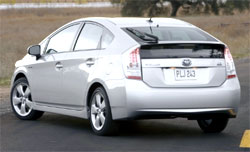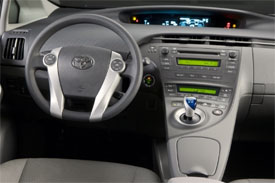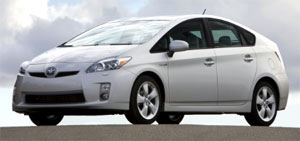2010 Toyota Prius
It’s been 12 years since the Toyota Prius began its run as the most prolific mass market hybrid car in the world, and since then the Prius has defined green motoring with impressive efficiency, cutting-edge technology, smart packaging, and yes, truly iconic styling. Well now it’s time for an all-new Prius, and more of the same, only better.
Being the proverbial leader of the green car movement does not mean there isn’t room for progress, so the 3rd-generation 2010 Toyota Prius hybrid arrives with enhancements on nearly every front.
Starting with greater efficiency and more power, the new Prius is equipped with a 1.8-liter Atkinson-cycle 4-cylinder engine, replacing its former 1.5-liter. Engine output is now 98 horsepower and 105 pound-feet of torque, a near 30 percent jump on both counts. The re-engineered Hybrid Synergy Drive system has a smaller electric motor and a more powerful battery than before, and when engaged, bumps total horsepower 22 percent to 134 horses.
This full hybrid system now utilizes an electric water pump, and a smaller, lighter, AC/DC inverter with its own direct cooling system. Exhaust heat is used to warm engine coolant and the cabin faster, while a cooled EGR system omits the need for fuel enrichment during high loads. Technologies shared with the new Lexus RX 450h hybrid crossover.
 Taken together, they give the Prius nicely improved fuel efficiency. Preliminary Government Fuel Economy Ratings are an impressive 51 city/48 highway. The Prius’ 50 mile-per-gallon combined mileage is 4 miles-per-regular gallon better than the previous car and an increase of 9 over the first-generation.
Taken together, they give the Prius nicely improved fuel efficiency. Preliminary Government Fuel Economy Ratings are an impressive 51 city/48 highway. The Prius’ 50 mile-per-gallon combined mileage is 4 miles-per-regular gallon better than the previous car and an increase of 9 over the first-generation.
Certified as both a “Super Ultra Low Emissions Vehicle” and an “Advanced-Technology Partial Zero Emissions Vehicle” in California, Toyota claims the Prius produces 70 percent fewer pollutants than the average new gas-powered car.
Furthermore, the new Prius now has three driving modes. There is, of course, “EV mode” for low-speed electric-only propulsion for up to one mile; “Eco-Mode” for slower throttle responses to increase fuel economy in normal highway driving; and “Power Mode” to kick up the Prius’ performance with more power for passing, merging into higher-speed traffic, or simply getting across an intersection with greater confidence.
We experienced the Prius’ peppier attributes on a mixture of roads north of San Francisco. Aside from the upshot of acceleration, Toyota retuned the existing suspension for better handling and stability. The electric steering has a quick and more weighty feel. Turn-ins are fast enough, but there’s still quite a bit of body roll. On the stopping side, the Prius benefits from a new optimized regenerative braking system that recaptures more energy than before.
Although the just mid-size Prius rides on a new platform, wheelbase remains the same, and overall length increases just slightly. The hybrid’s iconic wedge-shape design also remains, but with more of a forward lean. The peak of the roof has been moved back almost four inches to improve aerodynamics and rear headroom. The Prius now has a 0.25 drag coefficient, the lowest of any mass-produced car.
Front and rear corners are also more sharply designed, with sportier LED headlights. The side character line is bolder, leading back to a rear spoiler, and the newly optimal 17-inch wheels give the Prius a brawnier stance.
 The reshaped exterior results in a better configured passenger cabin with more shoulder room all-around. The control layout is familiar, but more stylish, with the focal point still being a centered digital cluster with multi-information display for monitoring vehicle efficiency and fuel consumption.
The reshaped exterior results in a better configured passenger cabin with more shoulder room all-around. The control layout is familiar, but more stylish, with the focal point still being a centered digital cluster with multi-information display for monitoring vehicle efficiency and fuel consumption.
For climate, the more efficient air-conditioning system has a pollen filter and ion generator. Plus you can order a moon roof with solar panels that runs a vent fan to reduce the cabin temperature while parked.
But one of the biggest improvements we noticed right off are the front seats. Vastly more comfortable then before, and now with height adjustment. The steering wheel now tilts and telescopes too.
Seven airbags comes standard, including one for the driver’s knees, while rear seat headroom is up slightly, leg room drops over 2 1/2 inches. Odd for a commuter car. As before, the 60/40 bench folds to extend an already generous cargo area to a maximum of 39.4 cubic feet. There is also a wide under floor storage bin that’s perfect for stowing the luggage cover.
On the tech front, the Prius boasts a roster of new goodies. There’s Dynamic Cruise Control with a front emblem disguised radar unit; Lane Keep Assist, Toyota’s take on Lane Departure Warning; Intelligent Park Assist, for semi-automatic parallel parking; and Safety Connect, Toyota’s answer to OnStar.
As for pricing, Toyota is aggressively defending its hybrid turf against the new Honda Insight. Base for the 2010 Prius is $21,750 with freight. That’s $1,000 less than the car it replaces, and only $1,300 more than the smaller Insight.
So can a great thing be made better? Of course it can, and the new 2010 Toyota Prius Hybrid is proof positive. As the cleanest and most efficient mass produced vehicle on the planet, the third-gen Prius has just widened the gap between itself and the rest of the greening automotive world.
Specifications
- Engine: 1.8-Liter Atkinson-cycle 4-Cylinder
- Horsepower: 98
- Torque: 105 Lb Feet
- EPA: 51 MPG City/ 48 MPG Highway






